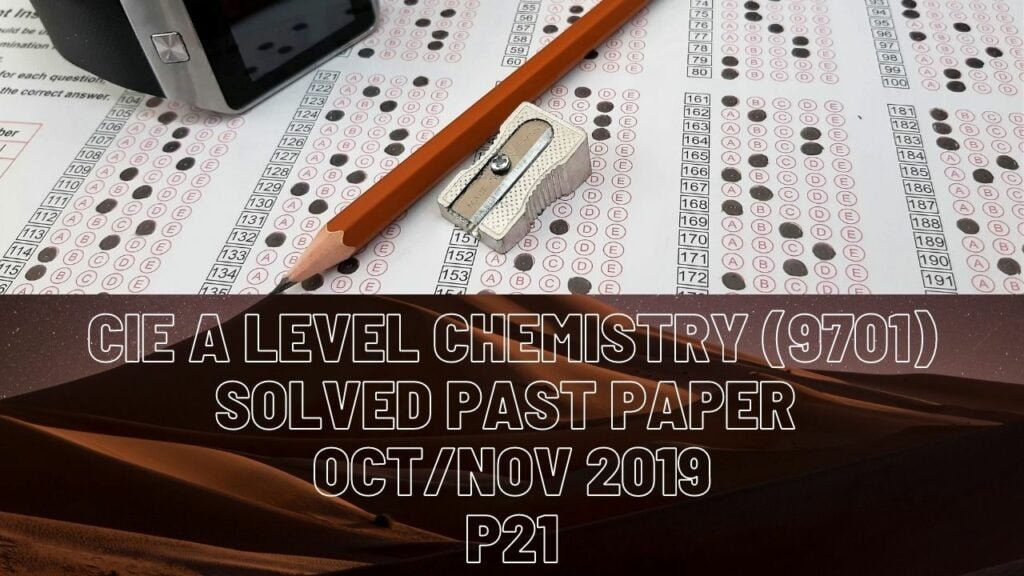
CIE A Level Chemistry (9701) Solved Past Paper Oct/Nov 2019 P21
1 ai) Oxidizing agents bring oxidation to other species in the reaction and get reduced themselves. In this Q, MnO2 is the oxidizing agent which oxidizes Cl- ion from -1 to 0 and gets reduced from +4 to +2.
b) Volatility is a property which explains how fast a substance vapourizesmand it decreases down goup VII. Vapourization is quicker at the top of group VII since they have less number of electrons and hence intermolecular force of attraction (temporary induced dipoles) is less as compared to that of elements down group VII.
2a) Bonding for the first 3 compounds is ionic because its between one metal and one non-metal. The last 2 compounds are covalently bonded because bonding is between 2 non-metals. Structure of ionic bondings are giant lattice; SiO2 has strong intermolecular forces which gives it a giant molecular structure and SO3 has weak intermolecular forces which gives it a simple molecular structure. Also SiO2 has got a giant network of bonding which is as strong as of graphite.
b iii) metal oxides+water——-> metal hydroxide
c ii) One Se=O breaks and two Se-O bonds form and enthalpy for this reaction is –346 kJ/ mol. Bond breaking is endothermic and thus positive sign is associated with 1 Se=O bond breaking. Bond formation is exothermic so negative sign is associated with 2 Se-O bonds forming.
3 aii) For fuels, we need hydrocarbons of as smaller carbon chain as possible to make it easier to get burnt.
b iv) Enthalpy change of combustion of thiophene would be energy required for 1 mole of thiophene to completely combusts. In the Q, only (0.63g/Mr of thiophene) moles of thiophene gets burnt and 15884J of energy was required to burn this number of moles. Enthalpy change of combustion is always negative because energy is given out.
4 aii) Sp2 hybridisations have an atom bonded to other atoms with 1 pie bond and 3 sigma bonds. C=O has 1 sigma and 1 pie bond, rest of the bonds of C are sigma bonds.
bi) Aldehyde to carboxylic acid is an oxidation reaction which means it needs an oxidizing agent so it could be either acidified KMnO4 or acidified K2Cr2O7. Heat under reflux is the condition.
ii) (CH3)3CCO2H has a -COOH functional group which has hydrogen bonding whereas CH3CO2(CH2)2CH3 has an ester linkage -COO with only van der waal forces. Since hydrogen bonding is stronger than most of the intermolecular forces, A exists as a solid at room temperature.
iii) NaBH4 is a reducing agent, it converts aldehyde to primary alcohol.
iv) U is an ester which needs a carboxylic acid and an alcohol. A is a carboxylic acid which means T has an alcohol functional group -OH. Right side of ester linkage comes from alcohol which means -OH group must be attached to second carbon atom of the chain.
ci) Carbonyl compounds show orange precipitate in 2,4-DNPH
ii) Y reacts with both 2,4-DNPH and Fehling’s solution, this means it has an aldehyde group attached.
iv) You must have a structure which has Carbon in the middle bonded to 4 different atoms or group of atoms.
v) For this part of the Q, you need Data Booklet. Z is not a carbonyl compound because of no reaction with 2,4-DNPH and Fehling’s solution. For geometrical isomerism, you need a C=C where each C atom should be attached to 2 different atoms or group of atoms but there should be an atom or group of atoms that is common on both C=C. Like in this Q, H is common on both C=C which forms geometrical isomer.
vii) HCN acts as a nucleophile where H-CN bond breaks heterolytically and CN takes away both the electrons. Similarly C=O of X breaks heterolytically where O takes away both the electrons which were being shared in covalent bond. Now CN: has a negative charge which attracts partial positively charged C atom of X: Similarly O: also has a negative charge which attracts H+ of H-CN.